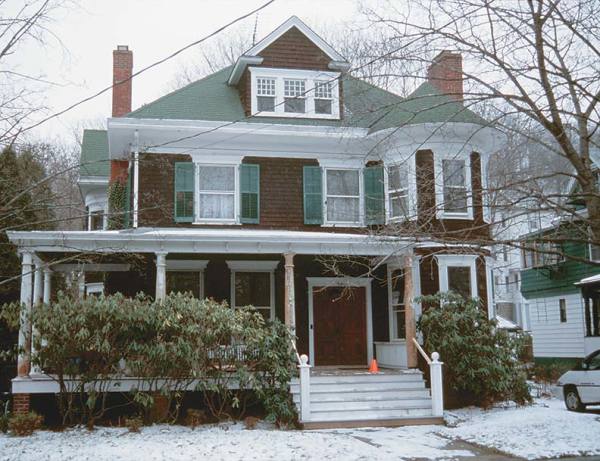
Tony notes that architecturally, the house is “part Colonial Revival, part Queen Anne, and part eBay.”
Just days before we visited what would be our future old house, the owner passed away. She was 87 and had been a serial beagle owner, living with one long-eared, sharp-nosed pup after the other during the 60 years she’d been in the house. At first, this bit of background struck us as really, really cute and adorable. Picture parades of beagles marching through the years—and peeing through them, as well. Oh, yes. While our predecessor loved animals, she hated training them, but this would be a future discovery.
We’d been hunting for a house for close to a year. I knew that house restoration starts with a dream and a vision. I had very clear, solid, guy views. I wanted a huge garage (where I could store books, boats, cars), a giant basement, and a house with real character. My fiancé, Celine, also set some specifics: very Victorian (or Vicky as we came to call it), within an hour of Manhattan, and not in New Jersey. In addition, Celine wanted a turret, pocket doors, and a house that was as much a magnificent piece of furniture as it was a home.
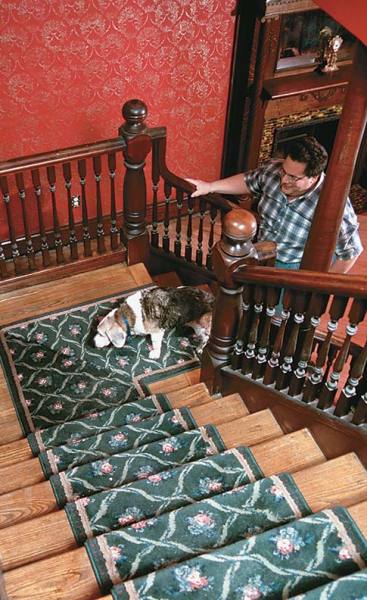
One of Gypsy’s favorite perches is in the middle landing of the large front-hall staircase, where she can poke her snout between balusters to supervise contractors.
We’d chewed through a few real estate agents. Most seemed less than comfortable with older homes. Others used fingernail-on-blackboard phrases such as “If these walls could talk,” when what we wanted to hear was solid advice on a project we knew would take years to accomplish. Nonetheless, we did meet a couple of gems. One of them, Greg Schatz of Albert Schatz Realtors in Ossining, New York, actually understood our desires. He found a listing with an eight-letter description that made most prospective homebuyers shudder with terror but utterly energized us, novices that we were: NEEDS TLC (translation: huge house at an affordable price).
I’ll let Celine describe the place. “It doesn’t ooze curb appeal,” she says. “It’s not a gingerbread painted lady; it has a rather sedate, dignified exterior, but inside it’s spacious, elegant, and beautifully laid out, with gorgeous detailing that’s surprisingly intact.” Though it sounds a bit cliched, the house possessed a wonderful aura. It had been in the same family since it was built in 1903, and the last owner was an incredibly generous, active woman. Gypsy, the last of the owner’s beagles, was an extra prize, one made all the more valuable by some disturbing news. People were warning us she might be put to sleep if we didn’t take her.
When we first saw our house, two animals lived there—that we knew about. (The bats weren’t included in the count.) There was Daisy, who looked gaunt, sick, and fragile, and 17-year-old Gypsy, who defined the word dogged as she arthritically stumped after us into every corner of the house and then followed us into the back yard and garage, her nose constantly sniffing at our heels.
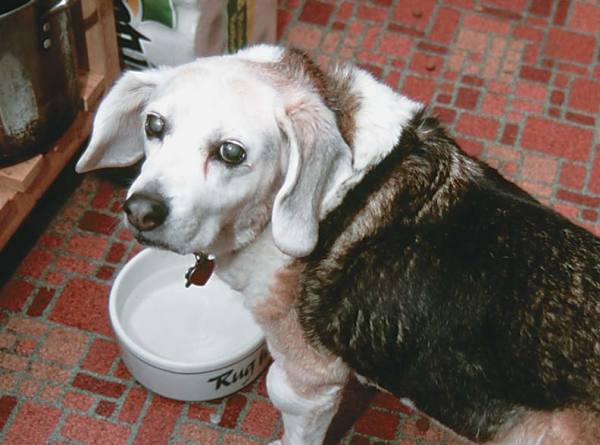
Gypsy came complete with personal effects, such as her bowl inscribed “Rugwrecker.”
I asked the lawyer to write in the contract that if we didn’t get the dog, we wouldn’t take the house. Gypsy might not be in great shape, but she had those gorgeous, needy beagle eyes, and we couldn’t deal with the karma of killing a dog to get our home.
We sensed that whatever the legal papers might say about the estate, someone knew who the house’s real owner was, and she had four feet. Gypsy didn’t really appear to accept us. She was, after all, a purebred, and we are anything but. However, she did appear comfortable with our presence, so we put in a bid immediately. During the long, difficult negotiations, we got regular reports on the dogs from the house’s caretaker, Tommy. Daisy, sadly but probably appropriately, was put to sleep a few weeks after we met her. A couple of weeks after that, we got news that Gypsy had had a massive stroke. We figured, “That’s it for her,” but we didn’t know our furry future landlady at all. Though at first Gypsy couldn’t walk, Tommy the caretaker helped her take care of herself. The vet was optimistic, saying that dogs usually recovered from strokes quite well. Little did we know how truly he spoke.
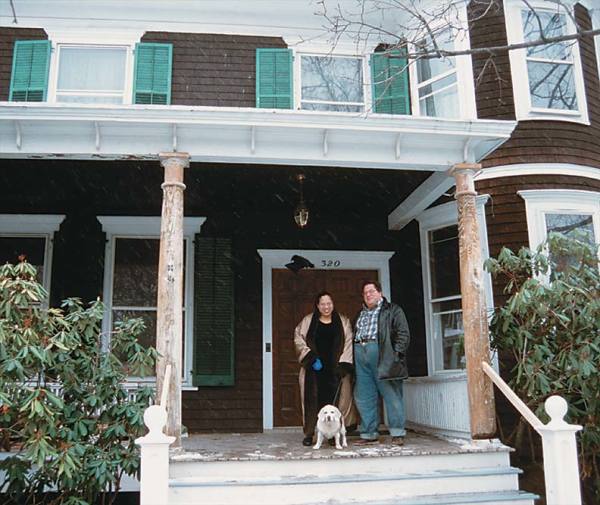
Celine, Tony, and Gypsy surveying the work-in-progress front porch, which did extra duty as a “pre-disposal storage area” for several rooms’ worth of discarded carpeting.
Our commitment to Gypsy was cemented one day when we went up to the house to check on some work that was necessary before we could complete the purchase. She was lying in the sunlight in the reception hall when we arrived. Our entry woke her up, and she staggered to her feet. Gypsy looked the very portrait of a stroke victim, her head twisted to one side, her legs moving out of sync.
Gypsy peered at us through cataract-fogged eyes, grunted and started moving. That’s when Celine and I witnessed one of the most heroic acts we think we’ll ever see an animal perform. (You probably need to be a dog person to understand why we were so moved.) Picture this. Our contractor had a large drop cloth spread out over the floor. It had seen years of use and looked pretty much like an overdone Jackson Pollock canvas. Gypsy understood that the cloth was something special, and thus valuable. As we watched, transfixed, we realized that Gypsy also had a very full bladder. Even so, the determined way she moved showed that the last place she wanted to go was our contractor’s tarp.
Somehow she stumbled and staggered over the drop cloth and onto the grim, green carpet that then covered our home’s hardwood maple floors. There, she let loose a small, yellow fountain, going where many dogs had undoubtedly gone before. At that point, Celine and I knew we had to do everything in our power to keep Gypsy alive.
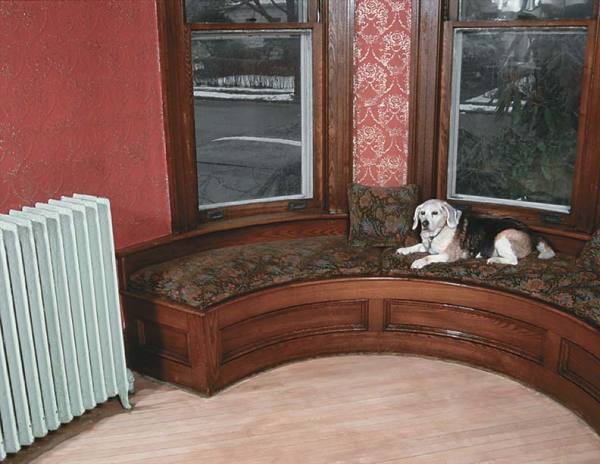
Gypsy, the canine queen of three dogs in the house, poses regally on the window seat of the tower room.
Besides, Gypsy acted like a very sedate, quiet animal who would be no problem at all to handle. As her health improved, we soon learned differently. I’d been told Gypsy was happy with her backyard and didn’t want to go out much. With old dogs, as with old houses, things are not always what they seem. The day we moved in, we arrived after our moving van. The doors to the house were open and there was Gypsy, wandering down the middle of the street. “So what?” I thought. “She’s too old to run.” Then and there I learned that one of Gypsy’s great joys in life is to be chased. So we went tottering down the street, me pulling my belt off with one hand to use as a leash and holding my pants up with my other hand.
Since then, Gypsy’s trained us to walk her three times a day. We try to make sure to do so. She’s made it clear she might throw us out if we don’t.







